Boosting Performance in Older PCs: Effective Strategies
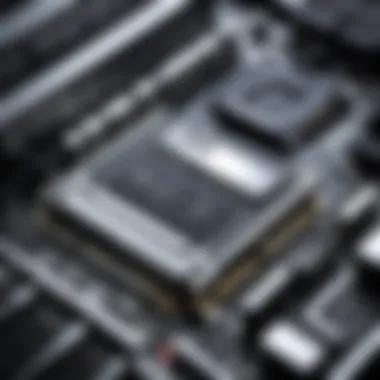
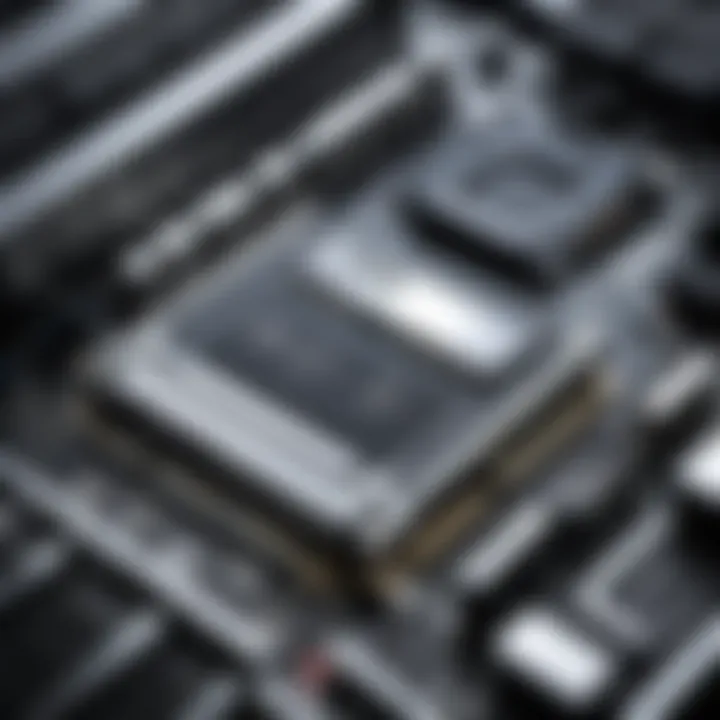
Intro
As computers age, they can start to show their years, becoming sluggish and unresponsive. This problem is often exacerbated by the rapid pace at which technology advances. However, there is hope. Users can take a variety of practical steps to breathe life back into their aging PCs. From discerning when to upgrade hardware to optimizing software configurations, understanding these strategies is crucial for those looking to make the most out of their equipment. Embracing these solutions doesn’t just keep your PC running longer; it can also enhance your overall digital experience.
In this article, we will expound on various tactics to rejuvenate an older machine. This will include hardware and software strategies, as well as other important maintenance practices. The strategies explored here are not just fleeting tips; they represent a coherent approach to maximizing the longevity and performance of your computer, drawing on an understanding of the technical landscape that tech enthusiasts are passionate about.
Product Overview
When considering enhancements for an aging PC, it’s essential to assess both the existing hardware and software in use. Taking stock will help identify which areas need improvement.
Key Features
- Upgrade Potential: Check whether components like RAM or the hard drive can be upgraded.
- Compatibility: Ensure that new parts are compatible with your existing system.
- Software Flexibility: Consider whether your current operating system can streamline processes more efficiently.
Specifications
To tackle performance issues effectively, let's evaluate some typical specifications that could be targeted for upgrades:
- RAM: More memory can significantly speed up multitasking.
- Storage: Transitioning to a Solid State Drive (SSD) can reduce boot times and speed up data access significantly.
- Processor: Understanding your CPU's capabilities can help determine if an upgrade is worth the investment.
Performance Analysis
Delving into the performance of your aging PC begins with a thorough analysis of its current capabilities. By breaking it down into key aspects, users can identify specific ways to bolster performance and improve overall efficiency.
Speed and Efficiency
Feeling like your PC is stuck in molasses? Here’s how to tackle that slowpoke nature:
- Clean Up: Uninstall unnecessary programs that bog down your system.
- Disable Startup Programs: Limit what loads at startup to improve boot times.
- Optimize Settings: Adjust visual effects in your operating system to prioritize performance.
Battery Life
If you're on a laptop, battery life can be a critical concern. Here are methods to enhance it:
- Power Settings: Utilize power-saving modes to reduce drainage from the battery.
- Background Applications: Shut down applications running in the background that drain power unnecessarily.
- Regular Updates: Keep drivers and software up to date to ensure you’re benefiting from the latest optimizations.
"A well-maintained PC can outlast any fleeting technological trend, keeping you connected to the digital world without breaking the bank."
Addressing the unique challenges presented by an aging PC requires a combination of hardware know-how and software savvy. By implementing these strategies, tech-savvy enthusiasts can prolong the life of their machines while enjoying a smoother, more responsive experience.
Understanding Performance Bottlenecks
In the realm of computing, performance bottlenecks are akin to the choke points in a water pipe, constricting the flow and hampering overall efficiency. For anyone grappling with an aging PC, it’s key to pinpoint these bottlenecks for numerous reasons. First and foremost, understanding where the slowdowns occur allows users to implement targeted solutions, rather than throwing parts or software tweaks against the wall to see what sticks. Ultimately, this translates to a more streamlined process and better resource allocation.
A common misconception is that performance issues are solely a matter of outdated hardware. While this can indeed be the culprit, the software environment and configurations contribute significantly too. By focusing on specific elements—like recognizing commonly encountered symptoms and analyzing core components—users can take a practical approach to rejuvenate their systems. This roadmap of understanding leads to more effective diagnostics, ultimately saving time and trouble.
Identifying Common Symptoms
Recognizing the signs of a sluggish PC is the first step in addressing performance bottlenecks. Users frequently find themselves frustrated with slow boot times, stuttering applications, and those annoying moments when the system feels like it's just holding its breath. Symptoms like these often reveal underlying issues, which might include:
- Lagging response times during file operations
- Frequent application crashes
- Excessive overheating due to overworked components
Each of these symptoms points to possible areas where the performance may be bottlenecked.
Analyzing Core Components
To truly grasp the performance issues of an aging PC, one must dive into the core components. Let’s break it down:
CPU Performance Limitations
The CPU, often referred to as the brain of a computer, is critical to overall performance. If it’s underpowered or running out of steam, even the flashiest GPU won’t pave the way for speed. A bottleneck in CPU performance typically shows up as sluggish multitasking or slow processing of data-heavy applications. Users should be aware that certain CPUs perform better for various tasks, and an antiquated CPU might struggle with modern software demands.
A prime example is the Intel Core i5 series. Known for its balance between performance and cost, it’s widely likable by both gamers and professionals. However, as software evolves, the demands can outstrip what it can handle. Thus, understanding the specific workload and the CPU's capability is vital.
Memory Capacity and Speed
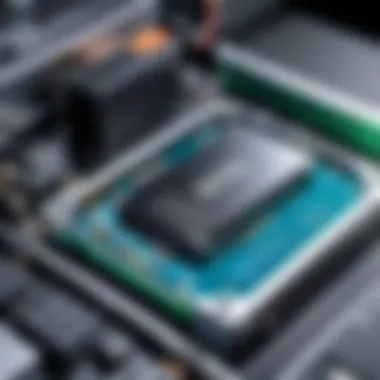
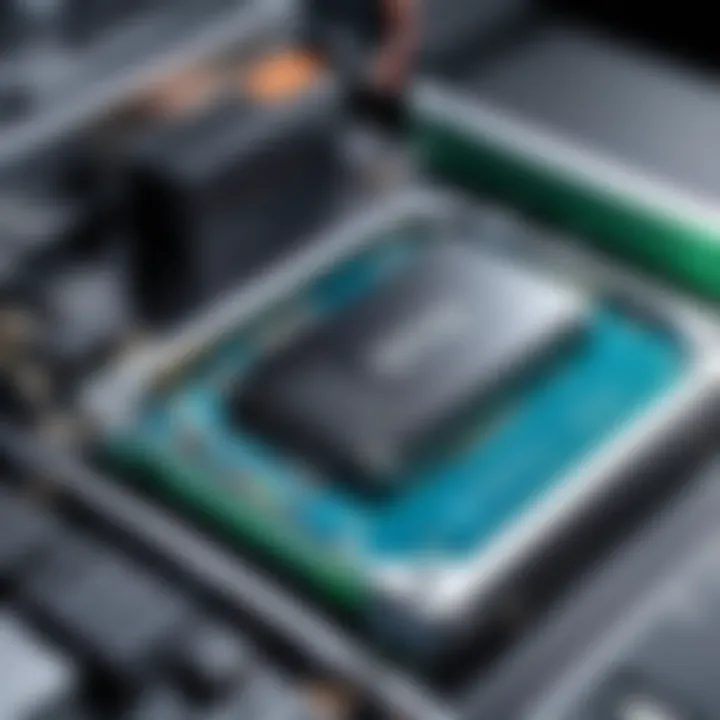
Diving into memory dynamics, users often overlook how RAM impacts performance. Insufficient RAM capacity leads to system slowdowns, particularly when juggling multiple tasks. Users may experience a computer that grinds to a halt when they have several tabs open or are running applications simultaneously.
For instance, a standard 8GB RAM can work wonders for basic usage, but once you throw heavy applications or multiple processes into the mix, it might just wave the white flag. RAM types also matter; DDR4 has become the norm for decent speed and efficiency, compared to its predecessors.
Storage Type and Dynamics
When it comes to storage, its type and performance dictate how quickly data can be accessed and written. Traditional Hard Disk Drives (HDDs) are often bottlenecks due to their slower read/write speeds compared to Solid State Drives (SSDs). Replacing an aging HDD with an SSD can lead to a significant uptick in performance. Users might notice that their operating system boots up in a flash, reducing the wait time dramatically.
To put this into perspective, a standard SSD might offer read speeds upwards of 500MB/s, compared to an HDD’s typical 100MB/s. This difference is night and day when it comes to performance.
In summary, identifying performance bottlenecks involves keen observations of symptoms, while analyzing core components sheds light on the underlying issues. By addressing these, users can embark on a journey to restore their aging PCs to former glory.
Software Adjustments for Enhanced Speed
Improving the performance of an aging PC isn't purely about swapping hardware components. Software tweaks often bring about significant performance enhancements, acting as the backbone that allows the hardware to function at its highest capacity. Adjusting these software settings can result in faster startup times, smoother multitasking, and improved overall responsiveness. The good news is that many methods are user-friendly and can be enacted without breaking the bank.
Operating System Optimization
Optimizing your operating system is like giving your PC a fresh coat of paint. It's crucial to ensure that everything runs like a well-oiled machine. Here’s how you can achieve that:
Disabling unnecessary startup programs
When you fire up your computer, it's not uncommon for a bunch of applications to start up with it. This phenomenon can slow down your boot time and make your computer feel sluggish right from the start. Disabling unnecessary startup programs is key to enhancing performance. By doing this, you can significantly reduce the time it takes for your system to become usable after powering it on.
One major advantage of disabling these programs is that you streamline the booting process. You can easily identify programs that often run in the background without you knowing—stuff like old software or third-party applications that no longer interest you. Yet, be cautious; some software might be necessary for hardware functioning.
Managing background processes
Often, a heap of applications can run invisibly, consuming system resources that your aging PC desperately needs for core tasks. Monitoring and managing these background processes can help alleviate performance dips. With tools like Task Manager on Windows or Activity Monitor on Mac, you can see what's hogging the resources.
What’s beneficial here is how you can pinpoint and terminate processes that aren’t essential. Once done, this can translate into better performance during tasks like gaming or video editing. However, be mindful not to close processes that are vital for your operating system's health. It's imperative to know what you're shutting down.
Updating system drivers
Keeping system drivers up to date is another critical component in the software optimization game. Properly updated drivers improve hardware functionality, enhancing compatibility with newer programs and operating systems. Regular updates can fix bugs that cause crashes or glitches, greatly improving your user experience.
The unique advantage here is that updated drivers can also lead to better performance across your hardware components. For instance, a graphics card with the latest driver is likely to provide smoother performance in high-intensity applications or games. However, there can be downsides, as occasionally new drivers may introduce issues rather than solve them, leading to frustrating rollbacks.
Cleanup and Maintenance Tools
Next up, let's turn to how cleanup and maintenance tools can tidy up your system, much like seasonal spring cleaning. A few adjustments and tools can go a long way toward keeping things spick and span.
Using disk cleanup utilities
Disk cleanup utilities are essential tools that help you clear away old files and unnecessary data cluttering your hard drive. Employing them can free up significant disk space, allowing your PC to perform tasks faster. The process involves identifying files that no longer serve a purpose—like temporary files, cache data, or old system files—and removing them.
One characteristic that makes these tools popular among users is their ability to automate the cleanup process. A few clicks can lead to sizable gains in speed and storage space. However, users must ensure they review what files they're deleting. Accidental removal of important files can lead to loss and regret.
Defragmenting and optimizing drives
Defragmenting can often take a backseat in discussions about performance enhancements but shouldn't be underestimated. Over time, files on a hard drive can become fragmented, which means they're scattered across the drive instead of being neatly organized. Run a defragmentation utility periodically, and you’ll find faster data retrieval times as the machine works less hard to access your files.
The notable benefit here is eliminating the guesswork in file storage—ensuring your files lay contiguous rather than spread out. However, it's worth noting that SSDs don’t require defragmentation, as they work differently and benefit from optimization settings instead.
Removing unused software
Finally, one of the simplest yet most impactful steps to speeding up your aging PC is to remove programs you don't use anymore. Over time, we accumulate software that may have once been useful but is now taking up precious system resources. Getting rid of unused programs can minimize the clutter and restore a smoother performance.
The beauty of this option lies in its simplicity. By sifting through your installed applications, you can clear up space and possibly avoid unnecessary background processes. But, be sure to critically evaluate whether any software truly serves no purpose—removing essential programs can hinder your computer’s capabilities.
"A clean PC is a happy PC. Always keep what you need and let go of what's not essential."
Employ these software adjustments wisely, and you will likely notice a significant bump in your PC’s performance. A few systematic changes can yield substantial results, keeping the old machine useful and responsive for everyday tasks.
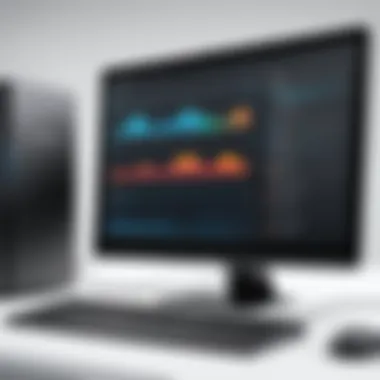
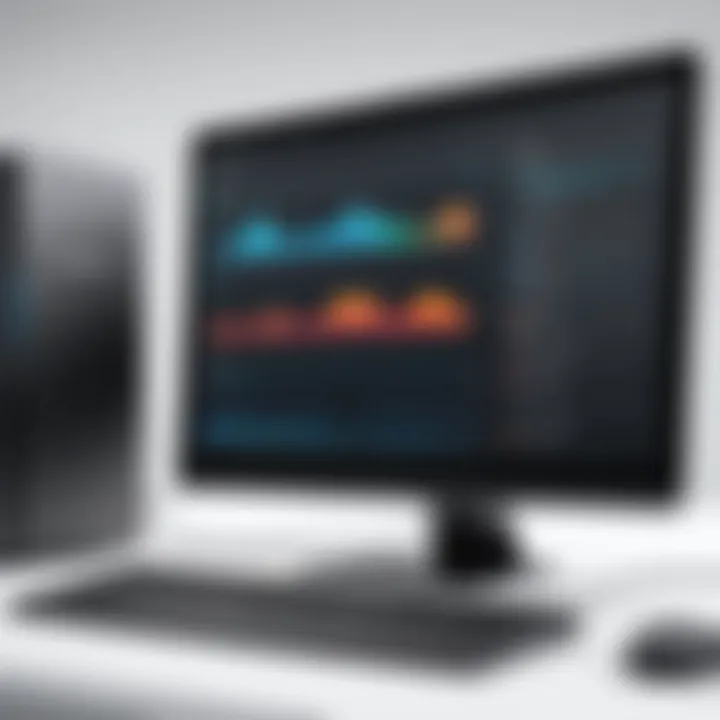
Hardware Upgrades: A Viable Option
When it comes to boosting the performance of an aging PC, hardware upgrades stand as one of the most effective strategies. Unlike software fixes, hardware improvements can directly enhance speed, capacity, and functionality. Upgrading your PC not only extends its lifespan but also tailors its capability to meet modern demands, making it a wise choice for anyone looking to maintain or enhance productivity.
It is essential to consider specific components that will offer the most significant impact. Memory upgrades, storage solutions, and graphics card enhancements can lead to noticeable improvements in system responsiveness and efficiency. Each of these aspects plays a pivotal role in ensuring that an aging PC does not become a relic of the past.
Memory Upgrades
Selecting the right RAM type
Choosing the correct type of RAM is fundamental for optimizing your system's overall performance. Many PCs can benefit from advancements in RAM technology, such as DDR4 or DDR5, which offer better speed and efficiency compared to older variants. For instance, opting for DDR4 can lead to smoother multitasking and faster data access.
The latency and frequency of the RAM also matter. Higher frequency RAM results in faster data processing, while lower latency reduces delays in communication between the RAM and CPU. Every tech-savvy user should understand that selecting RAM also involves considering the balance between speed and capacity to ensure the system meets users' needs.
Installation considerations
The installation process is crucial when upgrading RAM. It isn't just about slapping in new sticks; multiple factors need consideration. Knowing how many slots are available on the motherboard and whether it supports dual-channel memory can make a huge difference. For instance, installing RAM in pairs, when supported, can leverage increased memory bandwidth, substantially benefiting system performance.
Moreover, avoiding ESD (electrostatic discharge) during installation is critical to prevent damage to sensitive components. Taking necessary precautions can save a user from potential headaches in the future.
Compatibility checks
Compatibility checks cannot be overlooked. It's important to verify that the new RAM type is supported by both the motherboard and CPU. Each component should be compatible with the specified speed and capacity to ensure optimal performance.
Using resources like a PCPartPicker can be handy to ensure all selected hardware components work harmoniously. Wasting time and money on incompatible parts isn't just discouraging; it can also lead to further performance issues. Ensuring compatibility also saves future troubles when maintaining or upgrading further.
Storage Solutions
Benefits of SSDs over HDDs
When contemplating storage upgrades, the shift from hard disk drives (HDDs) to solid-state drives (SSDs) is perhaps one of the most impactful changes one can make. SSDs are significantly faster than HDDs, resulting in reduced load times and overall snappier performance.
One key characteristic of SSDs is that they have no moving parts, which not only enhances speed but also makes them less prone to mechanical failures. This aspect is particularly beneficial for users who rely on their PCs for critical tasks. Transitioning to an SSD provides a quantum leap in responsiveness, and they also consume less power, which can lead to enhanced battery life in laptops.
Hybrid storage options
Hybrid storage solutions offer a combination of HDD and SSD benefits. Utilizing an SSD for the operating system and critical applications while storing bulk data on an HDD can lead to a decision that balances performance and cost. This option offers more storage capacity at a lower price than SSD alone.
The hybrid approach allows users to upgrade their systems without breaking the bank, making it a favorite among value-conscious individuals. However, understanding where the data resides – which files are on the SSD versus the HDD – can present some challenges; careful planning is needed.
Implementing external storage
External storage options can complement internal upgrades. External hard drives or SSDs can be used to back up important files or free up internal space, improving system performance. Investing in a high-quality external drive means you can leverage the speed of SSDs while keeping larger, less frequently accessed files on slower HDDs.
In addition, external drives can be easily transported, offering the convenience of accessing files on various devices. But the potential downside lies in the risk of loss or physical damage to the external drive. Thus, safeguarding critical data is essential, no matter where it resides.
Graphics Card Enhancements
Choosing an appropriate GPU
Selecting a suitable graphics card is vital for users intent on gaming or graphics-intensive applications. A good GPU can transform an aging PC into a capable machine for the latest software, enhancing both performance and visual quality. Graphics cards such as NVIDIA's GeForce or AMD's Radeon series often provide substantial improvement, making them worthwhile investments.
The latest GPUs also support advanced features, like ray tracing and AI-enhanced graphics, which elevate the overall computing experience. However, it's crucial to consider the power supply and compatibility with the motherboard, as newer GPUs might demand more than old hardware can provide.
Installation process and challenges
Installing a new graphics card might seem straightforward but can present challenges. Users must ensure that they have adequate space in their PC case and sufficient cooling, as modern GPUs can generate significant heat during operation. Moreover, aligning the card with the PCIe slot is essential for proper functionality.
User guides from manufacturers provide step-by-step instructions, but even seasoned tech enthusiasts may face unforeseen issues such as driver conflicts or BIOS settings that need adjustments post-installation. Thus, diligence during the installation phase is paramount.
Impact on overall performance
A new graphics card can dramatically improve not only gaming performance but also productivity in creative applications such as video editing and 3D modeling. Observing faster frame rates and smoother graphics is often a direct result of an enhancement in visual capabilities.
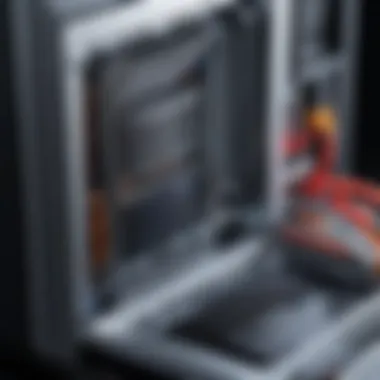
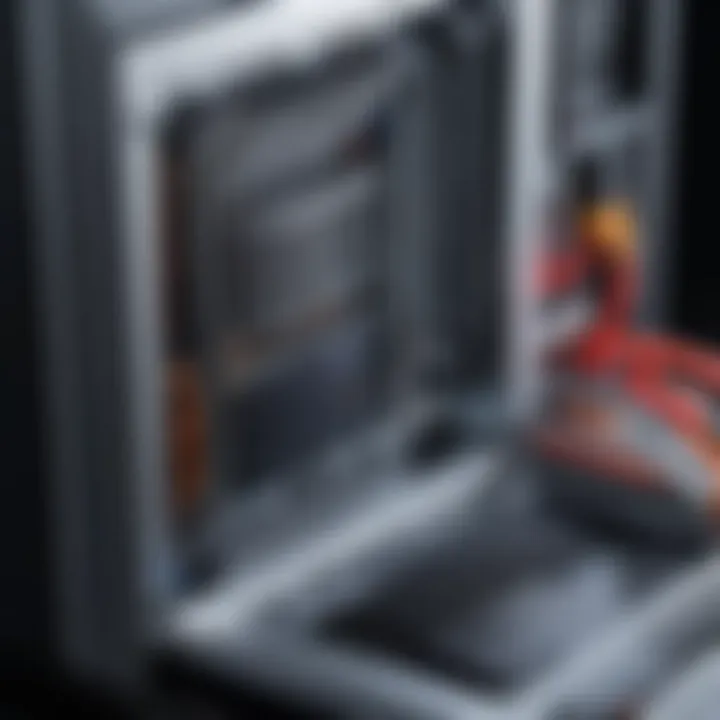
On the flip side, it’s important to recognize that upgrading the GPU sometimes leads to bottlenecks, particularly if the rest of the system isn't also upgraded. A powerful graphics card paired with outdated CPU parameters may lead to underwhelming results.
"When making the leap to a more robust GPU, consider the overall balance of your entire system to truly experience enhanced performance."
Network Optimizations
In today's interconnected world, having a swift and efficient network connection is crucial, especially for older PCs that tend to lag behind in performance. As technology progresses, network demands have increased, making it essential for aging machines to adapt. Implementing network optimizations can remarkably reduce latency and enhance the overall user experience. Moreover, it extends the lifecycle of older hardware, allowing them to perform more effectively in an era where seamless connectivity is indispensable. Here, we delve into various strategies that focus on upgrading existing network components and fine-tuning connection settings.
Upgrading Network Components
Router enhancements
Improving your current router is a paramount step that can significantly contribute to better network performance. Modern routers offer advanced technologies like dual-band frequencies and mesh systems, which provide more robust and reliable connections. One key characteristic of router enhancements is their ability to handle more devices without slowing down. For those who are crammed with multiple gadgets, this becomes a lifesaver. A unique feature of contemporary routers is Quality of Service (QoS), which prioritizes bandwidth for essential applications like video calls or gaming, ensuring uninterrupted service. However, high-end routers can be a bit pricey, so consider your current usage before splurging.
Selecting better network cards
Another essential element involves upgrading network cards, particularly if you're sticking with an older desktop. A better network card can improve wireless reception and increase overall connection speed. The standout feature here is the capability to achieve higher data transmission rates, which can make a noticeable difference during data-intensive tasks like streaming or downloading large files. A capture point worth mentioning is that some new network cards come with the latest Wi-Fi 6 technology, maximizing throughput and reducing congestion. Nevertheless, it’s vital to ensure that your existing motherboard is compatible before making a switch.
Understanding bandwidth management
Understanding how to manage your bandwidth is equally important in the performance equation. Bandwidth management helps in allocating the correct amount of internet speed to different devices and applications, which can prevent network congestion. A critical attribute of effective bandwidth management is its flexibility; you can prioritize specific applications, ensuring that high-bandwidth activities don’t hinder other tasks. For instance, video conferencing can be prioritized over background downloads. Keep in mind, though, that manual adjustments might be necessary on occasion, and some complex configurations can be daunting for less tech-savvy users, which could limit its effectiveness.
Optimizing Connection Settings
Adjusting network configurations
Optimizing your connection settings often yields immediate benefits. Adjusting network configurations such as IP addresses and DNS settings can minimize connection issues and enhance speed. A fundamental quality of network configurations is their simplicity; sometimes, just tweaking these settings can do wonders for overall connectivity. A notable aspect to consider is the improvement in network security these adjustments can bring. However, be careful while changing configurations as incorrect settings can lead to loss of internet access altogether.
Implementing QoS settings
Implementing QoS settings can also play a vital role in enhancing network performance. By prioritizing bandwidth for certain applications, especially under heavy load, users can enjoy smooth operations. The beauty of QoS lies in its capability to be molded to meet personal demands. Typically, enabling QoS is straightforward on most routers, which is a huge plus for everyday users. There is a downside, though; if not set up correctly, it could lead to performance issues instead of relieving them, so take your time going through the setup.
Evaluating Wi-Fi options and placements
Lastly, evaluating your Wi-Fi options and placements can dramatically impact the performance of your aging machine. The conventional approach is to ensure the router is centrally located in the house to diminish dead zones. Knowing that barriers like walls and furniture affect Wi-Fi signal strength, reorienting your setup can lead to better coverage. One appealing feature of new Wi-Fi technologies, like mesh systems, is their flexibility in covering larger areas. On the flip side, mesh systems can be more costly, so weigh the pros and cons based on space and need.
"Investing in network optimizations does not only enhance the performance of an aging PC but also prepares your setup for the future demands of technology."
In summary, optimizing your network can dramatically improve your PC's performance and overall efficiency. By upgrading hardware components and fine-tuning settings, you can make your set-up more responsive.
Ending: Sustaining Longevity and Performance
In an era where technology advances at breakneck speed, ensuring your aging PC remains effective and responsive is crucial. Performance lags don’t just frustrate users; they hamper productivity and impact the overall user experience. Sustaining performance over time involves a blend of regular maintenance, smart upgrades, and informed decisions about potential enhancements that can keep your machine in the game longer than expected.
Regular Maintenance Routines
Scheduling periodic updates
Updating your operating system and applications is vital for maintaining performance. It allows you to fix bugs, install security patches, and benefit from new features that enhance efficiency. The key characteristic of scheduling periodic updates is that it creates a mechanism whereby your system is always running on the latest software version. This practice has become increasingly recognized as a beneficial choice for keeping systems secure and performing well. The unique feature here is automation; many systems allow you to set updates to install during off-hours, minimizing disruption. However, while updates are generally advantageous, one should be wary of large updates that may occasionally introduce new issues or require additional resources temporarily.
Conducting hardware checks
Regular hardware checks are equally essential in sustaining your PC's performance. The process involves inspecting components like hard drives, memory, and cooling systems to spot any potential issues before they become significant problems. This method shines a light on any wear and tear, which is vital for older systems. One of its key characteristics is the proactive nature of these checks, ensuring issues don’t sneak up on you. However, while these checks can save headaches down the road, they can require tools and knowledge of how to interpret the results, making this a bit challenging for those who aren’t tech-savvy.
Establishing a cleanup schedule
An established cleanup schedule focuses on decluttering your system, removing unnecessary files, and freeing up space to optimize performance. This practice is characterized by its straightforward execution, as it can often be automated through built-in utilities or third-party tools. Such maintenance is a popular choice because it enhances system responsiveness, making it a good bet for anyone with a machine feeling a little sluggish. The unique feature here is the potential to reclaim hard drive space, leading to better overall operation. Nonetheless, if not monitored properly, automation can sometimes miss particularly stubborn files or lead to the accidental deletion of useful data.
Making Informed Upgrade Decisions
Evaluating cost vs. performance gains
When considering upgrades, evaluating the cost against potential performance gains is crucial. This analytical approach allows users to prioritize investments that will yield tangible benefits. The key characteristic is its data-driven nature, enabling users to make decisions based on actual performance metrics rather than guesswork. It’s a popular choice since it empowers users to stretch their budgets while maximizing efficiency. A unique aspect here involves using benchmarking tools to compare performance before and after an upgrade to determine ROI accurately. However, not all upgrades will proportionally translate into performance gains, making it critical to approach each potential investment with a discerning eye.
Understanding return on investment
Understanding return on investment goes hand-in-hand with performance evaluations. This concept measures the benefits gained from an upgrade against what it costs. This understanding is critical, especially for aging systems where each component might need separate consideration. The unique feature of evaluating ROI lays in its potential long-term savings; spending a little now can sometimes save big down the line. However, without diligent tracking, some users might overlook which upgrades provided the best returns, especially if multiple enhancements are made concurrently.
Future-proofing considerations
Future-proofing ensures that your upgrades and maintenance are aligned with potential technological advancements. This strategic foresight helps guard against rapid obsolescence. The key characteristic is that it allows you to make decisions that not only benefit current performance but also ensure compatibility with future tech trends. This consideration is immensely beneficial for tech enthusiasts who wish to get the most out of their investments. A unique feature of future-proofing is the capacity to mitigate the impact of emerging technologies, making it possible for older hardware to remain relevant. However, this strategy requires a keen eye for technology trends, which not everyone possesses, and could lead to overspending on features that might not materialize into mainstream usage.



